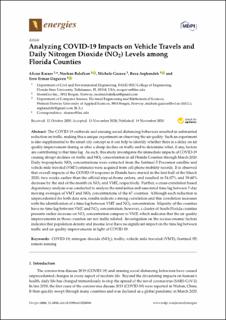| dc.contributor.author | Karaer, Alican | |
| dc.contributor.author | Balafkan, Nozhan | |
| dc.contributor.author | Gazzea, Michele | |
| dc.contributor.author | Arghandeh, Reza | |
| dc.contributor.author | Ozguven, Eren Erman | |
| dc.date.accessioned | 2021-03-15T09:30:47Z | |
| dc.date.available | 2021-03-15T09:30:47Z | |
| dc.date.created | 2021-01-28T12:14:32Z | |
| dc.date.issued | 2020 | |
| dc.identifier.citation | Karaer, A., Balafkan, N., Gazzea, M., Arghandeh, R., & Ozguven, E. E. (2020). Analyzing COVID-19 Impacts on Vehicle Travels and Daily Nitrogen Dioxide (NO2) Levels among Florida Counties. Energies, 13(22). | en_US |
| dc.identifier.issn | 1996-1073 | |
| dc.identifier.uri | https://hdl.handle.net/11250/2733327 | |
| dc.description.abstract | The COVID-19 outbreak and ensuing social distancing behaviors resulted in substantial reduction on traffic, making this a unique experiment on observing the air quality. Such an experiment is also supplemental to the smart city concept as it can help to identify whether there is a delay on air quality improvement during or after a sharp decline on traffic and to determine what, if any, factors are contributing to that time lag. As such, this study investigates the immediate impacts of COVID-19 causing abrupt declines on traffic and NO2 concentration in all Florida Counties through March 2020. Daily tropospheric NO2 concentrations were extracted from the Sentinel-5 Precursor satellite and vehicle mile traveled (VMT) estimates were acquired from cell phone mobility records. It is observed that overall impacts of the COVID-19 response in Florida have started in the first half of the March 2020, two weeks earlier than the official stay-at-home orders, and resulted in 54.07% and 59.68% decrease by the end of the month on NO2 and VMT, respectively. Further, a cross-correlation based dependency analysis was conducted to analyze the similarities and associated time lag between 7-day moving averages of VMT and NO2 concentrations of the 67 counties. Although such reduction is unprecedented for both data sets, results indicate a strong correlation and this correlation increases with the identification of a time lag between VMT and NO2 concentration. Majority of the counties have no time lag between VMT and NO2 concentration; however, a cluster of South Florida counties presents earlier decrease on NO2 concentration compare to VMT, which indicates that the air quality improvements in those counties are not traffic related. Investigation on the socioeconomic factors indicates that population density and income level have no significant impact on the time lag between traffic and air quality improvements in light of COVID-19. | en_US |
| dc.language.iso | eng | en_US |
| dc.publisher | MDPI | en_US |
| dc.rights | Navngivelse 4.0 Internasjonal | * |
| dc.rights.uri | http://creativecommons.org/licenses/by/4.0/deed.no | * |
| dc.subject | COVID-19 | en_US |
| dc.subject | nitrogen dioxide (NO2) | en_US |
| dc.subject | traffic | en_US |
| dc.subject | vehicle mile traveled (VMT) | en_US |
| dc.subject | Sentinel-5P | en_US |
| dc.subject | remote sensing | en_US |
| dc.title | Analyzing COVID-19 Impacts on Vehicle Travels and Daily Nitrogen Dioxide (NO2) Levels among Florida Counties | en_US |
| dc.type | Journal article | en_US |
| dc.type | Peer reviewed | en_US |
| dc.description.version | publishedVersion | en_US |
| dc.rights.holder | © 2020 by the authors. | en_US |
| dc.source.volume | 13 | en_US |
| dc.source.journal | Energies | en_US |
| dc.source.issue | 22 | en_US |
| dc.identifier.doi | 10.3390/en13226044 | |
| dc.identifier.cristin | 1881162 | |
| dc.source.articlenumber | 6044 | en_US |
| cristin.ispublished | true | |
| cristin.fulltext | original | |
| cristin.qualitycode | 1 | |

